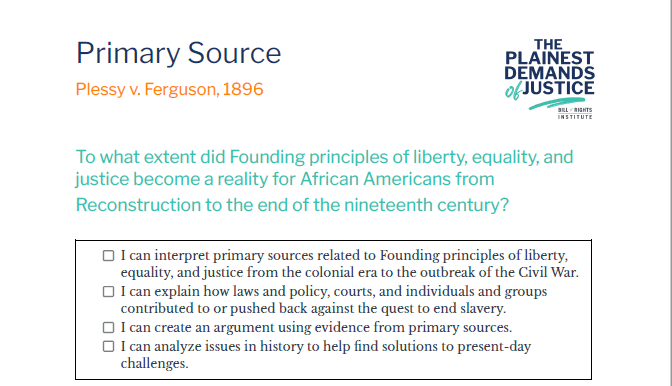Plessy v. Ferguson, 1896
Guiding Question: To what extent did Founding principles of liberty, equality, and justice become a reality for African Americans from Reconstruction to the end of the nineteenth century?
- I can interpret primary sources related to Founding principles of liberty, equality, and justice from the colonial era to the outbreak of the Civil War.
- I can explain how laws and policy, courts, and individuals and groups contributed to or pushed back against the quest to end slavery.
- I can create an argument using evidence from primary sources.
- I can analyze issues in history to help find solutions to present-day challenges.
Essential Vocabulary
| Plane | Level or place in society |
| Caste | Layer in a rigid social hierarchy |
| Tribunal | Court |
| Expositor | Someone who explains complicated topics |
Building Context
In the late nineteenth century, many southern states and localities passed segregation laws that separated the races in numerous aspects of public life such as bathrooms, businesses, and transportation. Louisiana passed the Separate Car Act of 1890 (Document 17), which required whites and Blacks to be separated on railroad cars. In September 1891, a group of New Orleanians formed the Citizens’ Committee to organize legal challenges to the law. With the support of the committee, Homer Plessy, a biracial man, purposefully violated the law and was arrested in June 1892. The Citizens Committee arranged Plessy’s immediate release from prison and raised money for attorney’s fees as his challenge made its way to the Supreme Court. Plessy’s attorneys, led by Albion Tourgée (Document 9), argued that the law violated the Thirteenth and Fourteenth Amendments. However, the court ruled in a 7-1 decision that the policy of “separate but equal” was constitutional and permissible. The court’s decision became settled law in such interpretations for nearly six decades. The following is taken from the majority opinion of the court, written by Justice Henry Brown, and the dissent, written by Justice John Marshall Harlan.
Plessy v. Ferguson, 1896
Source Link: https://www.law.cornell.edu/supremecourt/text/163/537#writing-USSC_CR_0163_0537_ZO
Opinion of the Court written by Justine Brown
. . . The case reduces itself to the question whether the statute of Louisiana [law enforcing segregation on railcars] is a reasonable regulation . . . we cannot say that a law which authorizes or even requires the separation of the two races in public conveyances is unreasonable, or more obnoxious to the fourteenth amendment than the acts of congress requiring separate schools for colored children in the District of Columbia, the constitutionality of which does not seem to have been questioned, or the corresponding acts of state legislatures. . . .
When the government, therefore, has secured to each of its citizens equal rights before the law. . . . If the civil and political rights of both races be equal, one cannot be inferior to the other civilly or politically. If one race be inferior to the other socially, the constitution of the United States cannot put them upon the same plane [level]. . . .
Dissenting Opinion written by Justice Harlan
In view of the Constitution, in the eye of the law, there is in this country no superior, dominant, ruling class of citizens. There is no caste [rigid social hierarchy] here. Our Constitution is color-blind, and neither knows nor tolerates classes among citizens. In respect of civil rights, all citizens are equal before the law. It is therefore to be regretted that this high tribunal [court], the final expositor [one who explains complicated topics] of the fundamental law of the land, has reached the conclusion that it is competent for a State to regulate the enjoyment by citizens of their civil rights solely upon the basis of race.
Comprehension and Analysis Questions
- Why does Justice Brown, on behalf of the Supreme Court, make the distinction between civil and political rights and social status?
- What would be the consequences for Black American rights under the Fourteenth Amendment, based on this interpretation?
- What did Justice Harlan mean when he said that the “Constitution is color-blind”?


